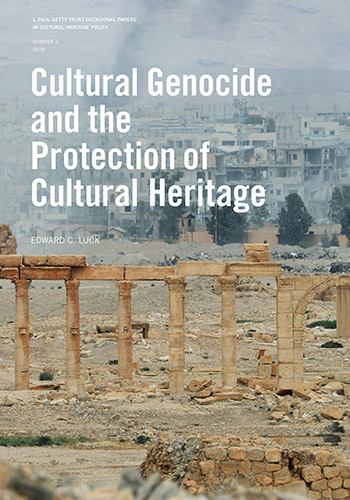
The second in a new series, the J. Paul Getty Trust Occasional Papers in Cultural Heritage Policy, is now available online. Image on cover: Palmyra’s Destroyed Heritage: The Historic and Modern Parts of Palmyra, Syria, April 21, 2016. © Mikhail Voskresenskiy / Sputnik via AP
The link between mass slaughter of human beings and attacks on cultural heritage was made as early as 1821 by the German Jewish poet Heinrich Heine when he wrote, “Where they have burned books, they will end in burning human beings.” More than a century later, in 1933, Heine’s books were among those burned on Berlin’s Opernplatz, presaging the murder of more than six million Jews in a vicious and calculated campaign of genocide.
In Cultural Genocide and the Protection of Cultural Heritage, the second in our J. Paul Getty Trust Occasional Papers in Cultural Heritage Policy series, Edward Luck of Columbia University explores the relationship between genocide and the destruction of cultural heritage.
Throughout, Luck draws on the work of Raphael Lemkin, the Polish Jewish legal scholar credited with coining the term genocide when he combined the Greek word genos (tribe, race) with the Latin suffix cide (the act of killing, as in homicide). For Lemkin, genocide meant both the mass killing of a group of people and “the destruction of the cultural pattern of a group, such as the language, the traditions, monuments, archives, libraries, and churches. In brief: the shrines of a nation’s soul.”
In a 1933 report submitted to the secretariat of the Bureau for the Unification of Criminal Law, Lemkin formulated two related crimes: barbarity and vandalism. Barbarity, he argued, “consisted of destroying a national or religious collectivity”; vandalism “consisted of destroying works of culture, which represented the specific genius of these national and religious groups. I wanted to preserve both the physical existence and the spiritual life of these collectivities.” Compelling as his arguments were, his submission was not accepted.
Eleven years later, Lemkin introduced the concept of genocide in his book Axis Rule in Occupied Europe: Laws of Occupation, Analysis of Government, and Proposals for Redress, published by the Carnegie Endowment for International Peace. In 1945, in preparation for the Nuremberg Trials, the four wartime powers—France, Great Britain, the United States, and the Soviet Union—agreed that genocide was a war crime. They did not, however, include the destruction of cultural heritage within the definition of genocide.
In 1948, the United Nations approved the Convention on the Prevention and Punishment of the Crime of Genocide, which entered into force in 1951. Once again, attacks on cultural heritage were not included in this treaty.
Since 2011, with the outbreak of the Syrian civil war and ISIS attacks on cultural heritage in Iraq and Syria, the question of whether the destruction of cultural heritage should be understood as an act of genocide is again being asked.
In 2014, Irina Bokova, then director-general of UNESCO, called the destruction of cultural heritage “cultural cleansing” and “cultural eradication.” She emphasized that “protecting heritage must be an integral part of all peace building,” that “the destruction of cultural heritage is a crime against humanity,” and that “this is a way to destroy identity. You deprive [people] of their culture, you deprive them of their history, their heritage, and that is why it goes hand in hand with genocide. Along with the physical persecution they want to eliminate—to delete—the memory of these different cultures.”
There is still a political and legal gap between genocide and the destruction of cultural heritage. But the gap is closing. In September 2016, the International Criminal Court sentenced Ahmad al-Faqi al-Mahdi, a member of a jihadist group linked to Al Qaeda, to nine years in prison for committing war crimes when he organized the destruction of shrines “above the tombs of venerated Muslim holy men and scholars in Mali.” As the New York Times reported, “Mr. Mahdi’s case has put a new focus on cultural destruction as a war crime, or as a crime against humanity. It reflects a growing belief that international law must address deliberate attacks on a people’s heritage when they are an intrinsic part of warfare, meant to destroy a group’s history and identity.”
As he viewed the smoky ruins of the Umayyad, or Great Mosque, in Aleppo, Mohammed Marsi, with his son at his side, shook his head and sighed, “The destruction for the whole country is indescribable, just like what happened to the mosque. If you knew the mosque before the damage, and saw it now, it is like someone who lost a child or part of his body.”
“Where they have burned books, they will end in burning human beings.” It is time to call the destruction of cultural heritage what it is: cultural genocide.
The paper, Cultural Genocide and the Protection of Cultural Heritage, is available for free download here.





Comments on this post are now closed.